|
|
|
|
|
Oil On
Canvas, Real Flavor of Old Masters
|
|

|
ARTWORKS
INDEX
A B C D E F G H I J K L M N O P Q R S T U V W X Y Z |
ARTISTS
INDEX
A B C D E F G H I J K L M N O P Q R S T U V W X Y Z |
|
|
| | |
|
|
 |
Henri Toulouse-Lautrec -- Click Here
|
|
French Post-Impressionist Painter and Printmaker, 1864-1901
Henri de Toulouse-Lautrec, a direct descendant of the counts of Toulouse, was born on Nov. 24, 1864, at Albi. His eccentric father lived in provincial luxury, hunting with falcons and collecting exotic weapons. Henri began to draw at an early age. He suffered a fall in 1878 and broke one femur; in 1879 he fell again and broke the other one. His legs did not heal properly; his torso developed normally, but his legs were permanently deformed.
Encouraged by his first teachers, the animal painters Rene Princeteau and John Lewis Brown, Toulouse-Lautrec decided in 1882 to devote himself to painting, and that year he left for Paris. Enrolling at the Ecole des Beaux-Arts, he entered the studio of Fernand Cormon. In 1884 Toulouse-Lautrec settled in Montmartre, where he stayed from then on, except for short visits to Spain, where he admired the works of El Greco and Diego Velazquez; Belgium; and England, where he visited Oscar Wilde and James McNeill Whistler. At one point Toulouse-Lautrec lived near Edgar Degas, whom he valued above all other contemporary artists and by whom he was influenced. From 1887 his studio was on the Rue Caulaincourt next to the Goupil printshop, where he could see examples of the Japanese prints of which he was so fond.
Toulouse-Lautrec habitually stayed out most of the night, frequenting the many entertainment spots about Montmartre, especially the Moulin Rouge cabaret, and he drank a great deal. His loose living caught up with him: he suffered a breakdown in 1899, and his mother had him committed to an asylum at Neuilly. He recovered and set to work again. He died on Sept. 9, 1901, at the family estate at Malrome. |
|
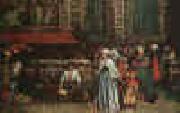 |
Hendrick Leys -- Click Here
|
|
1815-1869
Belgian
Hendrick Leys Gallery |
|
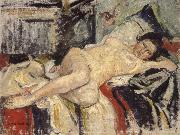 |
Heinrich Eduard Linde-Walther -- Click Here
|
|
1868-1939
|
|
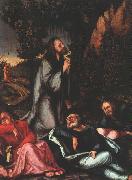 |
Hans Leonhard Schaeufelein -- Click Here
|
|
1480-1540
German
Hans Leonhard Schaeufelein Gallery
Hans Leonhard Schäufelein (c. 1480 ?C 1540) was a German painter, designer, and wood engraver.
He was born in Nuremberg, probably studied under Wohlgemut, and then became the assistant of Durer, whom he imitated. In 1512 he went to Augsburg and in 1515 removed to Nordlingen.
He is a graceful narrator, and his types, though rarely accurately drawn, are attractive, but he lacks power and depth. Characteristic early paintings are the altarpiece at Ober Sankt Veit, near Vienna (1502), "Scenes from the Life of Christ" (Dresden Gallery), and "St. Jerome" (Germanic Museum, Nuremberg).
To his Nordlingen period belong his masterpiece, the so-called "Ziegler Altar" for St. George's Church (1521), part of which is still in the church, part in the museum; "Scenes from the Story of Judith," in the town hall; and the illuminated Psalter for Count von Ottingen, now in the Berlin print room. His most important woodcuts are those for the Theuerdank of Emperor Maximilian.
Schäufelein created a playing card deck about 1535, which is regarded as a highlight in German 16th century playing card production. |
|
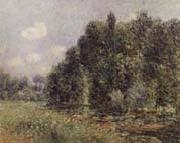 |
Gustave Loiseau -- Click Here
|
|
French, 1865-1935
French painter. He was apprenticed first to a butcher and in 1880 to a house painter. It was not until 1887, when he received a small inheritance, that he was able to devote himself to painting. He spent a year studying modelling and design at the Ecole des Arts D?coratifs in Paris and then entered the studio of the French landscape painter Fernand Just Quignon (b 1854) for six months in 1889. After settling in 1890 in Pont-Aven in Brittany, where he met the painters Maxime Maufra and Henri Moret (1856-1913), he produced such carefully executed works as the Green Rocks (1893; Geneva, Petit Pal.). It was not until 1894, however, that he met Gauguin on the latter return from Tahiti, and though he did not accept Gauguin synthetist ideas the encounter led to a stronger structure and freer brushstrokes in his subsequent work. |
|
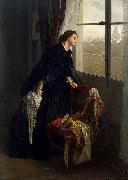 |
Gustave Leonard de Jonghe -- Click Here
|
|
painted Changeable Weather in 1875-76
|
|
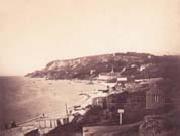 |
Gustave Le Gray -- Click Here
|
|
French Photographer, 1820-1884,French photographer, painter and teacher. He studied painting with Paul Delaroche until 1843. A study trip to Switzerland and Italy, financed by his parents, followed, but it was cut short by an untimely marriage in 1844, his sudden return to his family's home and the subsequent birth of two children in 1845 and 1846. Skilled in painting as an experimenter with pigments, he was attracted to the experimental side of the new paper negative processes available in France after 1847 and plunged into photography, probably to finance the burdens of the family life newly thrust upon him. His treatise, Trait? pratique de photographie sur papier et sur verre (1850), outlined his own variant of the dry waxed paper negative process using thinner paper, as well as a recipe for collodion on glass negatives rivalling that of the English inventor Frederick Scott Archer (see PHOTOGRAPHY, |
|
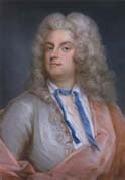 |
Gustaf Lundberg -- Click Here
|
|
Swedish, 1695-1786,Swedish painter and pastellist. He was orphaned early and brought up by his grandfather, the goldsmith Fredrik Richter (1636-1714). In 1710 he was briefly apprenticed to David von Krafft (1655-1724). Against von Krafft's advice, and at his own expense, he travelled to Paris in 1717. He studied first with Hyacinthe Rigaud, Nicolas de Largillierre and Jean-Fran?ois de Troy, learning to paint in a R?gence style less heavy and serious than that taught by von Krafft in Sweden. He also studied drawing under Pierre-Jacques Cazes at the Ecole des Beaux-Arts. In 1720 Rosalba Carriera came to Paris from Italy, bringing with her the fashionable technique of drawing in pastel chalks. Lundberg became her pupil and within a year had mastered the medium, charming the Parisians with his portraits. Until the arrival of Carriera, he had worked only in oils (e.g. the portrait of Gabriel Sack and his Wife Eva Bielke, 1730; priv. col.), but he now turned exclusively to pastels. He received portrait commissions from Louis XV (reg 1715-74), notably for those of his young queen Maria Leszczynska and of her parents Stanislav I Leszczynski and Catherine Opalinska (both 1725; Upplands Vesby, priv. col.), who at that time were living at Chambord. Through the agency of Carl Gustav Tessin, Lundberg was received (re?u) at the Acad?mie Royale de Peinture et de Sculpture in 1741. As his morceaux de reception he executed two portraits of Fran?ois Boucher and Charles-Joseph Nattier, shown at the Salon of 1743. |
|
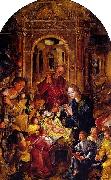 |
Gregorio Lopes -- Click Here
|
|
Gregorio Lopes (c. 1490 - 1550) was one of the most important Renaissance painters from Portugal.
Gregorio Lopes was educated in the workshop of Jorge Afonso, the court painter of King Manuel I. Later he himself became court painter for both Manuel I and for his successor, John III. In 1514 he married the daughter of Jorge Afonso, and in 1520 was knighted by Prince Jorge de Lencastre and entered the Order of Santiago.
The work of Gregorio Lopes mainly consists of painted religious altarpieces for various churches and monasteries in central Portugal. Between 1520 and 1525 he worked (together with Jorge Leal) in painting altarpieces for the Saint Francis Convent of Lisbon. Also in the 1520s he painted panels for the Church of Paraeso (Paradise), also in Lisbon. In his first fase, Gregorio Lopes also worked in Sesimbra, Setebal and in the Monastery of Ferreirim, in this latter case together with Cristevao de Figueiredo and Garcia Fernandes.
The painter moved in the 1530s to the city of Tomar, where he painted various panels for the Round Church of the Convent of Christ (1536 - 1539) and the main altarpiece of the Church of Saint John the Baptist (1538 - 1539). His last known works include altarpieces for the Convent of Santos-o-Novo in Lisbon (1540) and the Valverde Convent, near Évora (1545). |
|
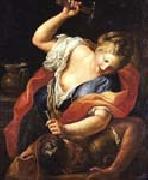 |
Gregorio Lazzarini -- Click Here
|
|
(1657 - 10 November 1730) was an Italian painter, mostly of religious subjects, and those from history and mythology.
Born in Venice, he initially trained with the Genovese painter Francesco Rosa, Girolamo Forabosco, and with the studio of Pietro della Vecchia. He joined the painters' guild in Venice in 1687. |
|
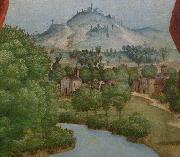 |
Girolamo dai Libri -- Click Here
|
|
(1474/1475 - July 2, 1555) was an Italian illuminator of manuscripts and painter of altarpieces, working in an early-Renaissance style.
He was born and mainly active in Verona. His father was Francesco dai Libri, and was so named because he was an illuminator of books. Girolamo's works were noted by Giorgio Vasari. Girolamo was a pupil of Domenico Morone. Dai Libri painted his first altarpiece, a Deposition from the Cross for Santa Maria in Organo in Verona, at the age of sixteen.
|
|
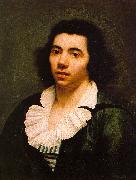 |
Girodet-Trioson, Anne-Louis -- Click Here
|
|
French Neoclassical Painter, 1767-1824
French painter. Originally named Girodet de Roussy or Roucy, he was a student of J.-L. David, and his classical training was sometimes at variance with his often eccentrically romantic expression. He won the Prix de Rome and while in Italy painted the Sleep of Endymion (1791; Louvre), a sensual and erotically ambiguous work that brought him widespread recognition. His Deluge (Louvre) demonstrates Girodet's interest in unusual color and lighting problems. Much of his work, including a series for Malmaison (Napoleon's residence), glorifies Napoleon. |
|
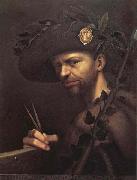 |
Giovanni Paolo Lomazzo -- Click Here
|
|
1538 - 1600
was an Italian painter, belonging to the second generation that produced Mannerism in Italian art and architecture. Gian Paolo Lomazzo was born in Milan from a family emigrated from the town of Lomazzo. His early training was with Giovan Battista della Cerva in Milan. He painted a large Allegory of the Lenten Feast for San Agostino in Piacenza (1567). He also painted an elaborate dome with Glory of Angels for the Capella Foppa in San Marco in Milan. He also painted the Fall of Simon Magus in the wall of the chapel. Lomazzo became blind in 1571, and turning to writing, produced two complex treatises that are milestones in the development of art criticism. His first work, Trattato dell'arte della pittura, scoltura et architettura (1584) is in part a guide to contemporary concepts of decorum, which the Renaissance inherited in part from Antiquity, which controlled a consonance between the functions of interiors and the kinds of painted and sculpted decors that would be suitable; Lespingola offered a systematic codification of esthetics that typifies the increasingly formalized and academic approaches typical of the later sixteenth century. His less practical and more metaphysical Idea del tempio della pittura ("The ideal temple of painting", 1590) offers a description along the lines of the "four temperaments" theory of the human nature and personality, |
|
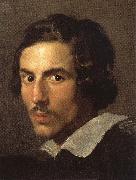 |
Giovanni Lorenzo Bernini -- Click Here
|
|
Italian Baroque sculptor, painter and architect.1598-1680
was a pre-eminent Baroque sculptor and architect of 17th Century Rome. Bernini was born in Naples to a Mannerist sculptor, Pietro Bernini, originally from Florence. At the age of seven he accompanied his father to Rome, where his father was involved in several high profile projects. There as a boy, his skill was soon noticed by the painter Annibale Carracci and by Pope Paul V, and Bernini gained the patronage exclusively under Cardinal Scipione Borghese, the pope's nephew. |
|
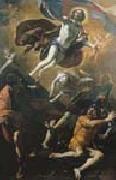 |
Giovanni Lanfranco -- Click Here
|
|
(26 January 1582 - 30 November 1647) was an Italian painter of the Baroque period.
Giovanni Gaspare Lanfranco was born in Parma, the third son of Stefano and Cornelia Lanfranchi, and was placed as a page in the household of Count Orazio Scotti His talent for drawing allowed him to begin an apprenticeship with the Bolognese artist Agostino Carracci, brother of Annibale Carracci, working alongside fellow Parmese Sisto Badalocchio in the local Farnese palaces. When Agostino died in 1602, both young artists moved to Annibale's large and prominent Roman workshop, which was then involved in working on the Galleria Farnese in the Palazzo Farnese gallery ceiling. |
|
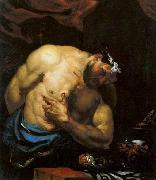 |
Giovanni Battista Langetti -- Click Here
|
|
Giovanni Battista Langetti (1625 - 1676), also known as Giambattista Langetti, was an Italian late-Baroque painter. He was active in his native Genoa, then Rome, and finally for the longest period in Venice.
He first trained with Assereto, then Pietro da Cortona, but afterwards studied under Giovanni Francesco Cassana, appeared in Venice by 1650s were he worked in a striking Caravaggesque style. He is thought to have influenced Johann Karl Loth and Antonio Zanchi. He painted many historical busts for private patrons in the Venetian territory and in Lombardy. He died at Venice in 1676.
|
|
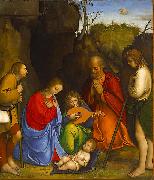 |
Giovanni Agostino da Lodi -- Click Here
|
|
was an Italian painter who was active from c. 1495 to c. 1525.
The attribution of his works has been dubious for centuries, until his style and career was defined by the American art historian Bernard Berenson in the 1960s. One of his first identified work is the Pala dei Barcaioli ("Boatmen Altarpiece") in the church of San Pietro Martire at Murano. His only signed work is the St. Peter and St. John the Evangelist in the Pinacoteca di Brera, which shows Lombard influeces, such as that of Bramantino.
Later he was also influenced by Leonardo da Vinci's style, as visible in the Christ Washing the Feet of the Apostles in the Gallerie dell'Accademia of Venice. After moving to Venice in the wake of Ludovico Sforza's fall, he returned to Milan in 1506. He subsequently executed works for privates and for the Certosa di Pavia; one of his late works, the Calvary, is housed in the National Gallery in Prague. He also collaborated with Marco d'Oggiono for a polyptych in the church of Santa Maria della Pace in Milan, some panels of which are now in the Pinacoteca di Brera.
|
|
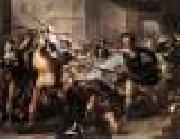 |
GIORDANO, Luca -- Click Here
|
|
Italian Baroque Era Painter, ca.1634-1705
,Italian painter and draughtsman, active also in Spain. He was one of the most celebrated artists of the Neapolitan Baroque, whose vast output included altarpieces, mythological paintings and many decorative fresco cycles in both palaces and churches. He moved away from the dark manner of early 17th-century Neapolitan art as practised by Caravaggio and his followers and Jusepe de Ribera, and, drawing on the ideas of many other artists, above all the 16th-century Venetians and Pietro da Cortona, he introduced a new sense of light and glowing colour, of movement and dramatic action. |
|
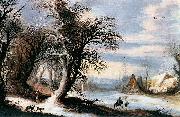 |
Gijsbrecht Leytens -- Click Here
|
|
(1586-1643 or 1656), also known as The Master of the Winter Landscapes, was a Flemish Baroque painter who specialized in winter landscapes influenced by Jan Brueghel the Elder and Gillis van Coninxloo. He became a master in Antwerp's guild of St. Luke in 1611, but little else is known of his career. Like his contemporaries in Antwerp, Abraham Govaerts and Alexander Keirincx, Leytens painted wooded landscapes populated with small figures, bracketed by strong repoussoir trees. His paintings, however, were generally winter scenes, a recognized specialty known as a Winterken ("little winter"). |
|
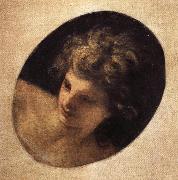 |
Gian Lorenzo Bernini -- Click Here
|
|
Italian sculptor , b. 1598, Napoli, d. 1680, Roma
,Italian architect and artist credited with creating the Baroque style of sculpture. He began his career working for his father, a sculptor. Among his early sculptures are Apollo and Daphne (1622 -C 24) and an active David (1623 -C 24). Under the patronage of Urban VIII, the first of eight popes he was to serve, he created the baldachin over the tomb of St. Peter in Rome. Bernini's architectural duties increased after 1629, when he was appointed architect of St. Peter's Basilica and the Palazzo Barberini. His works often represent a fusion of architecture and sculpture, as in the Cornaro Chapel, in Santa Maria della Vittoria, Rome, with its celebrated theatrical sculpture, The Ecstasy of St. Teresa (1645 C 52). His greatest architectural achievement is the colonnade enclosing the piazza before St. Peter's. |
|
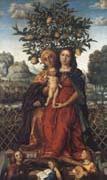 |
Gerolamo Dai Libri -- Click Here
|
|
Italian Painter, ca.1474-1555 |
|
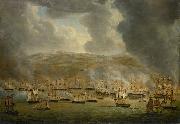 |
Gerardus Laurentius Keultjes -- Click Here
|
|
painted The assault on Algiers by the allied Anglo-Dutch squadron in 1817
|
|
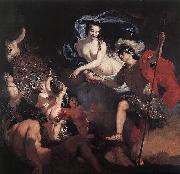 |
Gerard de Lairesse -- Click Here
|
|
Gerard or Gerard de Lairesse (11 September 1640 or 1641 - June 1711) was a Dutch Golden Age painter and art theorist.
Lairesse was born in Liege. His broad range of talent included music, poetry, and the theatre. He was perhaps the most celebrated Dutch painter in the period following the death of Rembrandt. His treatises on painting and drawing, Grondlegginge der teekenkonst (1701) and Groot Schilderboek (1707), were highly influential on 18th-Century painters like Jacob de Wit. Students of De Lairesse included the painter Jan van Mieris. He died in Amsterdam. |
|
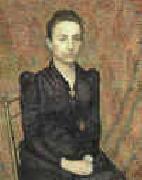 |
Georges Lemmen -- Click Here
|
|
1865-1916
French
Georges Lemmen Gallery
Belgian painter and decorative artist. He showed a precocious talent, first exhibiting in 1875. His only formal study was at a local school of drawing. Between 1884 and 1886 he showed at the Essor group in Brussels paintings that were based on D?rer and Holbein and closely related to those of Lemmen's contemporary, Khnopff. When Lemmen became a member of Les XX in 1888 his style developed quickly, influenced principally by French Neo-Impressionism and the English Arts and Crafts Movement. Lemmen adopted the pointillist technique following Seurat's first showing with Les XX in 1887. His best pointillist canvases include The Carousel (1890-91; Toulon, Mme Thevenin-Lemmen priv. col., see Belgian Art, 1880-1914, exh. cat., New York, Brooklyn Mus., 1980, p. 118, fig. 47) as well as portraits of Julie (1891; Chicago, IL, A. Inst.) and Mme Lemmen (1894-5; Paris, Mus. d'Orsay). |
|
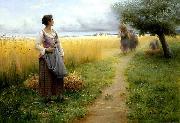 |
Georges Laugee -- Click Here
|
|
Georges Laugee was born in Montivilliers on December 19, 1853. His father, Desire Laugee, was an important French Realist artist; a contemporary of Jules Breton and specialized in portraying the workers in the field. Georges received his early training with his father and then, like many artists of his time, continued his studies at le Ecole des Beaux-Arts. There he studied at the ateliers of Isidore Pils and Henri Lehmann where he mastered the art of life studies and sketching.
In 1877 he made his debut at the Paris Salon and in 1881 was awarded the bronze medal for his Salon entries of that year: En Octobre and Pauvre aveugle. Following his love of nature and the farm worker, Laugee focused on scenes of everyday life. His works, often featuring the peasants tending their animals or working in the fields, are filled with light and realism.
Among the works that Georges chose to exhibit at the Paris Salons were; his 1890 submissions Le Repos and Le Retour des Champs; 1897 submission Sous leaverse (In the Storm) and his 1904 works Deux Amies and Au Temps des bles murs, which portrayed peasant girls in the country. At the Salon of 1906 he exhibited Soleil Couchant (Sunset) and Heure doree (Golden Hour) and continued to exhibit works of similar subject matter through 1928.
In 1889 he participated in the Exposition Universelle, where he received a bronze medal and in the Exposition Universelle of 1900 was awarded the silver medal for his painting entitled Au printemps de la vie (In the Springtime). From 1907 -- 1909 Laugee was a Membre du Comite de la Societe des Artistes Français and was a member of the Jury at the Salon from 1908 -- 1910.
Laugee painting entitled The Favorite. exhibited at the Paris Salon of 1891 and a very similar composition to Bergere et Mouton (featured below) - was illustrated in Famous Paintings of the World, published in 1894. The accompanying caption reads as follows:
In every family, however impartial the parents try to feel, there is always one child for whom, could she bring herself to confess it, the mother has a place in her heart a little warmer than she keeps for any other. The little shepherdess in this charming picture is exemplifying this universal truth of human nature, in her quiet encouragement of the approaches of the favorite lamb of her little flock. This is the pet lamb that she helps over all the stony places, and with which she shares even her own frugal meal. It is a simple story the artist has chosen to tell; but he has set it in a scene of tender and idyllic beauty, thoroughly appropriate to the gentle theme of affection he has selected for the central thought. He has contrasted effectively the simplicity of the shaded hillside nook, speckled with daisies and peopled with the inoffensive flock, and the ripe, full glory of the day, resplendent in the high-banked clouds, and reflected from the still surface of the breezeless summer lake. The photograph reproduction of this canvas has very successfully preserved the painty qualities of the original, so completely transferring to the engraving the technique of the artist that it is impossible that this should be anything other than what it is -- a direct engraving from a masterly painting in oil colors.
Laugee first atelier, located at 20, boulevard Flandrin, Paris, was also the home of the great realist artist Julien Dupre brother-in-law) and just after Dupre death in 1910, Laugee moved to 23, boulevard Lannes. By 1923 he had relocated to 123, Rue de la Tour; where it appears that he remained for the rest of his life. |
|
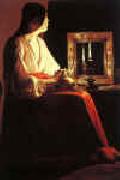 |
Georges de La Tour -- Click Here
|
|
1593-1652
French
Georges de La Tour Galleries
His early work shows influences from Caravaggio, probably via his Dutch followers, and the genre scenes of cheats??as in The Fortune Teller ??and fighting beggars clearly derive from the Dutch Caravaggisti, and probably also his fellow-Lorrainer, Jacques Bellange. These are believed to date from relatively early in his career.
La Tour is best known for the nocturnal light effects which he developed much further than his artistic predecessors had done, and transferred their use in the genre subjects in the paintings of the Dutch Caravaggisti to religious painting in his. Unlike Caravaggio his religious paintings lack dramatic effects. He painted these in a second phase of his style, perhaps beginning in the 1640s, using chiaroscuro, careful geometrical compositions, and very simplified painting of forms. His work moves during his career towards greater simplicity and stillness ?? taking from Caravaggio very different qualities than Jusepe de Ribera and his Tenebrist followers did.
He often painted several variations on the same subjects, and his surviving output is relatively small. His son Etienne was his pupil, and distinguishing between their work in versions of La Tour's compositions is difficult. The version of the Education of the Virgin, in the Frick Collection in New York is an example, as the Museum itself admits. Another group of paintings (example left), of great skill but claimed to be different in style to those of de La Tour, have been attributed to an unknown "Hurdy-gurdy Master". All show older male figures (one group in Malibu includes a female), mostly solitary, either beggars or saints.
After his death in 1652, La Tour's work was largely forgotten until rediscovered by Hermann Voss, a German scholar, in 1915. In 1935 an exhibition in Paris began the revival in interest among a wider public. In the twentieth century a number of his works were identified once more, and forgers tried to help meet the new demand; many aspects of his œuvre remain controversial among art historians. |
|
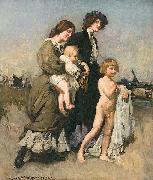 |
George Washington Lambert -- Click Here
|
|
(13 September 1873 - 29 May 1930) was an Australian artist, known principally for portrait paintings and as a war artist during the First World War.
Lambert was born in St Petersburg, Russia, the posthumous son of George Washington Lambert (1833 - 25 July 1873, in London) of Baltimore, Maryland. The younger Lambert's mother was Annie Matilda, nee Firth, an Englishwoman. Mother and son soon moved to Werttemberg, Germany, to be with Lambert's maternal grandfather. Lambert was educated at Kingston College, Yeovil, Somerset. The family, consisting of Lambert, his mother and three sisters, decided to emigrate to Australia. They arrived in Sydney aboard the Bengal on 20 January 1887. |
|
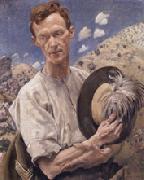 |
George W.Lambert -- Click Here
|
|
Russia-born Australian portrait painter
1873 - 1930
Australian painter, draughtsman and sculptor. He lived for a period in Europe and emigrated to Australia in 1887. He trained under Julian Rossi Ashton, gaining early recognition for his draughtsmanship. In 1901 he studied in Paris at the Acad?mie Colarossi under Auguste Del?cluse (b 1855). He was strongly influenced by the work of Diego Vel?zquez and Edouard Manet. The work of Sandro Botticelli later inspired him to paint in a high key and with an enhanced realism, as in Important People (1914; Sydney, A.G. NSW). He lived in England from 1902 to 1921 |
|
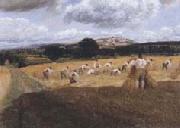 |
George Robert Lewis -- Click Here
|
|
English, 1782-1871 |
|
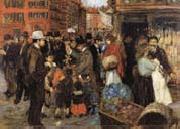 |
George Luks -- Click Here
|
|
August 13.1866-October 29.1933,American painter and draughtsman. He lived as a child in the mining town of Shenandoah, PA, but moved to Philadelphia in 1883. The facts of his early career were later confused by the wild stories fabricated by him. After a short stint in vaudeville, he spent a year at the Pennsylvania Academy of Fine Arts, Philadelphia. From 1885 he was in Europe, living most of the next decade in D?sseldorf, Munich, Paris and London, intermittently attending German and French art academies. In 1894 Luks became an artist-reporter for the Philadelphia Press, where he befriended Robert Henri, John Sloan, William J. Glackens and Everett Shinn. |
|
 |
George Loring Brown -- Click Here
|
|
American Hudson River School Painter, 1814-1889,American painter and illustrator. He was apprenticed at about 14 to the Boston wood-engraver Alonzo Hartwell and had produced scores of illustrations by 1832, when he turned to painting and sailed to Europe for further training. After brief stays in Antwerp and London, he settled in Paris, where he was admitted to the atelier of Eugene Isabey. Returning to America in 1834, Brown produced illustrations, portraits and landscapes. He travelled throughout the north-eastern USA, sketching in watercolour and in oil. |
|
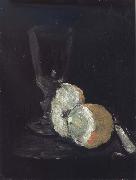 |
George Leslie Hunter -- Click Here
|
|
Scottish Painter, 1877-1931 |
|
|
|
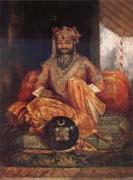 |
George Landseer -- Click Here
|
|
b.1833 Succ c.1844
r.1852-1886
|
|
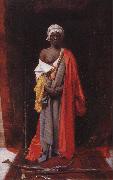 |
George L. Seymour -- Click Here
|
|
British, act. 1876 - 1916
Seymour was a son of Lord Hugh Seymour (himself a son of Francis Seymour-Conway, 1st Marquess of Hertford) and Anna Horatia Waldegrave (a daughter of James Waldegrave, 2nd Earl Waldegrave) and entered the Royal Navy in 1797. He captained HMS Pallas during the Battle of Basque Roads and HMS Leonidas and HMS Fortun??e during the War of 1812. For his part in the latter war, he was appointed a CB in 1815 (alongside many other Captains) and a KCH in 1831 (and later a GCH in 1834). He rose through the ranks in the navy over the years and in 1852 was appointed a KCB (and later a GCB in 1860) and finally as an Admiral of the Fleet in 1866. |
|
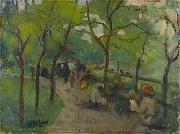 |
George Benjamin Luks -- Click Here
|
|
(August 13, 1867-October 29, 1933) was an American realist artist and illustrator. His vigorously painted genre paintings of urban subjects are examples of the Ashcan school in American art.
Luks was born in Williamsport, Pennsylvania, to Central European immigrants. His father was a physician and his mother was an amateur painter and musician.The Luks family (George, his parents and five siblings) eventually moved to Pottsville, in Southern Pennsylvania near the coal fields. In this setting, he learned at a young age the importance of compassion by watching how his parents helped the coal miners' families, and many believe that this is the reason why lower class New Yorkers were often Luks's subject matter. Luks studied at the Pennsylvania Academy of Fine Arts before he traveled though Europe where he attended several art schools. Later he went to Desseldorf where he lived with a distant relative, a retired lion-tamer. He abandoned Desseldorf for the more stimulating spheres of London and Paris. He then returned to Philadelphia in 1893 where he was an illustrator for the Philadelphia Press where he met John Sloan, William Glackens, and Everett Shinn. They would meet at the studio of Robert Henri, an artist who emphasized the depiction of ordinary life, shunning genteel subjects and painting quickly. The group became known as the "Philadelphia Five". In 1896, Luks moved to New York and began his art career there as the premier humorist artist for the New York World. During his time as an illustrator there, he lived with William Glackens. |
|
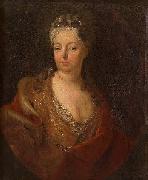 |
Georg Lisiewski -- Click Here
|
|
(1674 -1750 ) - Painter
|
|
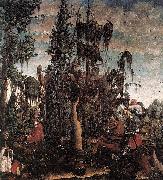 |
Georg Lemberger -- Click Here
|
|
German born 1490- died 1540. Nationality: German. |
|
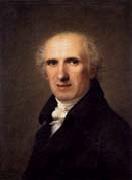 |
Gaspare Landi -- Click Here
|
|
Italian, 1756-1830,was an Italian painter of the Neoclassic period, active in Rome and his native city of Piacenza. He is said to have been a fun-loving younth, but in 1781 he procured a subsidy to study painting in Rome from patron and distant relative, Marquis Giambattista Landi. At age 25, he moved to Rome to work under Domenico Corvi and Pompeo Battoni. He is considered a rival of Vincenzo Camuccini. Two of his pictures were once in the Pinacoteca at Parma, Diomedes and Ulysses bearing off the Palladium (1783) and the Marriage of Abraham and Sarah. Above one of the altars in the church of the Santa Casa at Loreto there is a later work by this Landi showing the Madonna addolorata. A major work is his large canvas representing the fainting of Christ as he struggles along over the road to Calvary weighted down by the burden of the Cross, Lo Spasimo for San Giovanni at Piacenza. It hung opposite Vincenzo Camuccini's Presentation. Landi became a member of the Accademia di San Luca of Rome in 1805, professor of the theory of painting in 1812, and president of the Academy in 1817. He was also made a Chevalier of the Order of the Iron Crown, of the Order of San Giuseppe, and of a Neapolitan order. About 1820 he returned to Piacenza, intending to remain there, but soon tired of the monotonous existence of a provincial town, and in 1824 reestablished himself at Rome. His last work was an Assumption and was placed in the church of San Francesco di Paola, at Naples. He returned to Piacenza in 1829, where he died. |
|
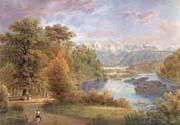 |
Gabriel Lory Pere -- Click Here
|
|
Bern 1763-1840 Bern |
|
|
|
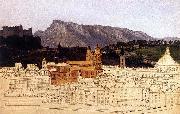 |
Friedrich Loos -- Click Here
|
|
was an Austrian Biedermeier style painter, etcher and lithographer. He was born in Graz on 29 October 1797. He studied at the Vienna Academy with Joseph Mössmer and also went on study tours through the Austrian Alpine regions. From 1835 to 1836 he lived in Vienna, and as of 1846 he sojourned in Rome. He then moved to Kiel, where he worked as a drawing teacher at the university as of 1863 and where he also died on 9 May 1890. In his pictures he emphasized light and color in order to loosen up his painting, as well as to harmonize and unite the details.
|
|
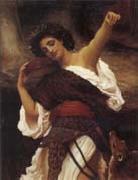 |
Frederick Leighton -- Click Here
|
|
1830-1896
He was an English painter and sculptor. His works depicted historical, biblical and classical subject matter. Leighton was born in Scarborough to a family in the import and export business. He was educated at University College School, London. He then received his artistic training on the European continent, first from Eduard Von Steinle and then from Giovanni Costa. When in Florence, aged 24, where he studied at the Accademia di Belle Arti, he painted the procession of the Cimabue Madonna through the Borgo Allegri. He lived in Paris from 1855 to 1859, where he met Ingres, Delacroix, Corot and Millet. Flaming JuneIn 1860, he moved to London, where he associated with the Pre-Raphaelites. He designed Elizabeth Barrett Browning's tomb for Robert Browning in the English Cemetery, Florence in 1861. In 1864 he became an associate of the Royal Academy and in 1878 he became its President (1878?C96). His 1877 sculpture, Athlete Wrestling with a Python, was considered at its time to inaugurate a renaissance in contemporary British sculpture, referred to as the New Sculpture. His paintings represented Britain at the great 1900 Paris Exhibition. Icarus and DaedalusLeighton was knighted at Windsor in 1878, and was created a baronet eight years later. He was the first painter to be given a peerage, in the New Year Honours List of 1896. |
|
 |
Frederic,lord leighton,p.r.a.,r.w.s -- Click Here
|
|
1830-1896
English painter and sculptor. He studied in Florence. His first exhibited picture, which showed Cimabue's Madonna being carried through the streets of Florence, was purchased by Queen Victoria in 1855. Leighton was president of the Royal Academy from 1878 until his death. |
|
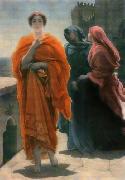 |
Frederic Leighton, 1st Baron Leighton -- Click Here
|
|
Frederic Leighton, 1st Baron Leighton PRA (3 December 1830 - 25 January 1896), known as Sir Frederic Leighton, Bt, between 1886 and 1896, was an English painter and sculptor. His works depicted historical, biblical and classical subject matter. Leighton was bearer of the shortest-lived peerage in history; after only one day his hereditary peerage ended with his death.
|
|
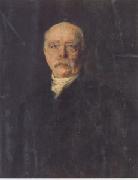 |
Franz von Lenbach -- Click Here
|
|
Shrobenhausen 1836-Munich 1904
German painter. The son of a master builder, he trained for his father's profession at the Kenigliche Landwirtschafts- und Gewerbeschule in Landshut, also working from 1851 in the sculpture studio of Anselm Sickinger (1807-73) in Munich. His elder brother, Karl August Lenbach (1828-47), had already become involved with painting, and it was through him that Franz Lenbach met Johann Baptist Hofner (1832-1913), an artist who had studied at the Akademie der Bildenden Kenste in Munich. They went on sketching expeditions together, and Hofner introduced him to plein-air painting. After spending two semesters at the Polytechnische Schule in Augsburg (1852-3), and some months in the studio of Albert Grefle (1807-89), a portrait painter in Munich, Lenbach entered the Akademie in Munich in 1854. In 1857 he attended the classes of Karl Theodor Piloty (later von Piloty), who was renowned for his history paintings. Lenbach produced his first important painting, the Angel Appearing to Hagar in the Desert (1858; destr.), while in this class, followed by Peasants Trying to Take Shelter from a Thunderstorm in a Chapel (1858; destr.; oil sketch, Schweinfurt, Samml. Schefer). The sale of this picture, together with a scholarship, enabled him to accompany Piloty on a journey to Rome with Ferdinand von Piloty (1828-95), |
|
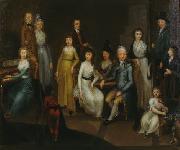 |
Franz Thomas Low -- Click Here
|
|
Lived in 18th centry. |
|
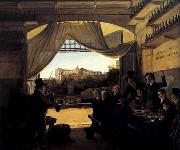 |
Franz Ludwig Catel -- Click Here
|
|
German Painter, 1778-1856,German painter. As a child, Catel helped carve small wooden figures in the toyshop owned by his father. With the encouragement of the printmaker Daniel Chodowiecki, Catel enrolled at the Berlin Kunstakademie, becoming a full member in 1806. In 1807, after already making a name for himself as a watercolourist and book illustrator, he began several years of study at the Acad?mie des Beaux-Arts in Paris, where his main subject was oil painting. In 1811 he moved to Italy, where he stayed for the rest of his life. Initially he wavered between Joseph Anton Koch's classically heroic style of landscape painting and the Romantic lyricism of the Nazarenes. Eventually he found that he could best exercise his technical ability, and most quickly achieve fame and fortune, by producing Italian landscapes. He specialized in Neapolitan scenes depicting festive folk customs; and such paintings proved popular with the mass of wealthy travellers who came to Italy after the Napoleonic Wars. |
|
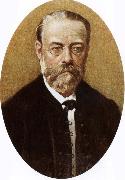 |
franz liszt -- Click Here
|
|
Period: Romantic (1820-1869)
Country: Hungary
Born: October 22, 1811 in Raiding
Died: July 31, 1886 in Bayreuth
Genres: Chamber Music, Choral Music, Concerto, Keyboard Music, Miscellaneous Music, Orchestral Music, Symphony, Vocal Music
|
|
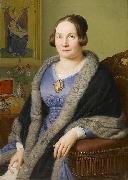 |
Franz Ittenbach -- Click Here
|
|
(April 18, 1813 - December 1, 1879) was a German religious painter from Königswinter, North Rhine-Westphalia, at the foot of the Drachenfels.
Ittenbach began his art education as a student of Kaufmann, then left to study under Franz Katz in Cologne. In 1832, Ittenbach became a pupil, at the age of 19, of the Desseldorf Academy, where he also received private lessons from its president, Schadow. He was a member of the Nazarene movement and associated himself mainly with three of his friends and fellow-students: Karl and Andreas Meller, and Ernst Deger. The four men travelled about in Germany, studying and painting together. From 1839 to 1842, Ittenbach lived in Italy. On his return, he stayed in Munich for some time. In 1849, he returned to Desseldorf. From 1859 until his death, he was a member of the artist club "Malkasten".
Ittenbach was exceedingly religious and persistently declined any commissions for mythological or pagan subjects. As a rule, he devoted his energies exclusively to church decoration. He would precede the execution of his greatest works with devout religious exercises, including confession and communion.
His finest paintings are said to be found at Bonn, in the church of St. Remigius, and in Breslau in a church dedicated to the same saint. There is also a remarkable "Holy Family" dated 1861, painted for Prince Liechtenstein in his private chapel near Vienna. Most of his other works can be found in various Catholic churches in Germany. His only important fresco was painted in 1844 in a church at Remagen.
Ittenbach was a popular painter in court circles, a member of most of the European academies, and the recipient of many medals and decorations. He painted a few portraits, but they were unimportant; his main work was his altar-pieces.
|
|
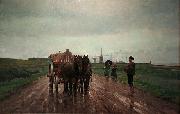 |
Frans van Leemputten -- Click Here
|
|
painted Aan de Schelde-arm in 1884 |
|
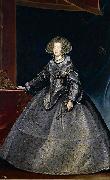 |
Frans Luycx -- Click Here
|
|
Frans Luycx.
Deutsch: Kaiser Ferdinand III. (1608-1657),
Brustbild.
Deutsch: um 1637/1638.
Medium. Deutsch. |
|
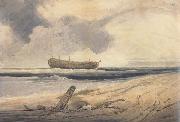 |
Francois Louis Thomas Francia -- Click Here
|
|
French, 1772-1839
was a French painter born in Calais and famous for his shore landscapes. He was the master of the young British painter Richard Parkes Bonington. This article about a French painter is a stub. |
|
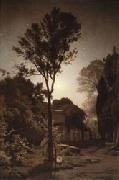 |
Francois Louis Francais -- Click Here
|
|
Plombieres 1814 - Paris 1897.
was born at Plombi??res-les-bains (Vosges), and, on attaining the age of fifteen, was placed as office-boy with a bookseller. After a few years of hard struggle, during which he made a precarious living by drawing on stone and designing woodcut vignettes for book illustration, he studied painting under Gigoux, and subsequently under Corot, whose influence remained decisive upon Français's style of landscape painting. He generally found his subjects in the neighbourhood of Paris, and though he never rivalled his master in lightness of touch and in the lyric poetry which is the principal charm of Corot's work, he is still counted among the leading landscape painters of his country and period. He exhibited first at the Paris Salon in 1837 and was elected to the Academie des Beaux-Arts in 1890. Comparatively few of his pictures are to be found in public galleries, but his painting of "An Italian Sunset" is at the Luxembourg Museum in Paris. Other works of importance are "Daphnis et Chloë" (1872), |
|
|
|
|
|
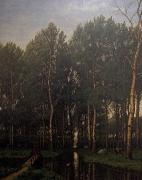 |
Francois Lamoriniere -- Click Here
|
|
painted View at Edegem in 1863 |
|
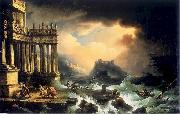 |
Franciszek Ksawery Lampi -- Click Here
|
|
(1782 - 1852) was a Polish Romantic painter.
|
|
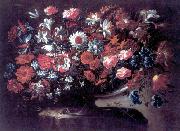 |
Francisco Lopez Caro -- Click Here
|
|
(1578-1662) was a Spanish painter of the Baroque period. Born in Seville, he was a pupil of Juan de las Roelas. We know very little of him, save that he painted with indifferent success in Seville until about 1660, when he went to Madrid where he spent the remainder of his life, and died in 1662. His works were mainly portraits, some of which are in private collections in Madrid, Salamanca, Granada, and Seville. |
|
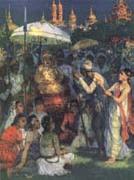 |
Francis Luis Mora -- Click Here
|
|
Uruguayan-born American Painter, 1874-1940 |
|
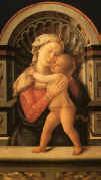 |
Fra Filippo Lippi -- Click Here
|
|
Italian
1406-1469
Fra Filippo Lippi Galleries
Lippi was born in Florence to Tommaso, a butcher. Both his parents died when he was still a child. Mona Lapaccia, his aunt, took charge of the boy. In 1420 he was registered in the community of the Carmelite friars of the Carmine in Florence, where remained until 1432, taking the Carmelite vows in 1421 when he was sixteen. In his Lives of the Artists, Vasari says: "Instead of studying, he spent all his time scrawling pictures on his own books and those of others," The prior decided to give him the opportunity to learn painting. Eventually Fra Filippo quit the monastery, but it appears he was not released from his vows; in a letter dated 1439 he describes himself as the poorest friar of Florence, charged with the maintenance of six marriageable nieces. In 1452 he was appointed chaplain to the convent of S. Giovannino in Florence, and in 1457 rector (Rettore Commendatario) of S. Quirico in Legania, and made occasional, considerable profits; but his poverty seems chronic, his money being spent, according to one account, in frequent amours. Vasari relates some romantic adventures of Fra Filippo that modern biographers are not inclined to believe. Except through Vasari, nothing is known of his visits to Ancona and Naples, nor of his capture by Barbary pirates and enslavement in Barbary, where his skill in portrait-sketching helped to release him. From 1431 to 1437 his career is not accounted for.
Portrait of a Man and Woman at a Casement , c. 1440
Metropolitan Museum of Art, New York City.In June 1456 Fra Filippo is recorded as living in Prato (near Florence) to paint frescoes in the choir of the cathedral. In 1458, while engaged in this work, he set about painting a picture for the convent chapel of S. Margherita of Prato, where he met Lucrezia Buti, the beautiful daughter of a Florentine, Francesco Buti; she was either a novice or a young lady placed under the nuns' guardianship. Lippi asked that she might be permitted to sit for the figure of the Madonna (or perhaps S. Margherita). Under that pretext, Lippi engaged in sexual relations with her, abducted her to his own house, and kept her there despite the nuns' efforts to reclaim her.
The result was their son Filippino Lippi, who became a painter no less famous than his father. Such is Vasari's narrative, published less than a century after the alleged events; it is not refuted by saying, more than three centuries later, that perhaps Lippo had nothing to do with any such Lucrezia, and perhaps Lippino was his adopted son, or only an ordinary relative and scholar. The argument that two reputed portraits of Lucrezia in paintings by Lippo are not alike, one as a Madonna in a very fine picture in the Pitti gallery, and the other in the same character in a Nativity in the Louvre, comes to very little; and it is reduced to nothing when the disputant adds that the Louvre painting is probably not done by Lippi at all[clarification needed]. Besides, it appears more likely that not the Madonna in the Louvre but a S. Margaret in a picture now in the Gallery of Prato is the original portrait (according to tradition) of Lucrezia Buti.
The frescoes in the choir of Prato cathedral, which depict the stories of St John the Baptist and St Stephen on the two main facing walls, are considered Fra Filippo's most important and monumental works, particularly the figure of Salome dancing, which has clear affinities with later works by Sandro Botticelli, his pupil, and Filippino Lippi, his son, as well as the scene showing the ceremonial mourning over Stephen's corpse. This latter is believed to contain a portrait of the painter, but there are various opinions as to which is the exact figure. On the end wall of the choir are S. Giovanni Gualberto and S. Alberto, while the vault has monumental representations of the four evangelists.
The close of Lippi's life was spent at Spoleto, where he had been commissioned to paint, for the apse of the cathedral, scenes from the life of the Virgin. In the semidome of the apse is Christ crowning the Madonna, with angels, sibyls and prophets. This series, which is not wholly equal to the one at Prato, was completed by Fra Diamante after Lippi's death. That Lippi died in Spoleto, on or about the 8th of October 1469, is a fact; the mode of his death is a matter of dispute. It has been said that the pope granted Lippi a dispensation for marrying Lucrezia, but before the permission arrived, Lippi had been poisoned by the indignant relatives of either Lucrezia herself or some lady who had replaced her in the inconstant painter's affections. This is now generally regarded as a fable, and indeed, a vendetta upon a man aged sixty-three for a seduction committed at the age of fifty-two seems hardly plausible. Fra Filippo lies buried in Spoleto, with a monument erected to him by Lorenzo the Magnificent; he had always been zealously patronized by the Medici family, beginning with Cosimo de Medici. Francesco di Pesello (called Pesellino) and Sandro Botticelli were among his most distinguished pupils.
The altarpiece Lippi painted in 1441 for the nuns of S. Ambrogio is now a prominent attraction in the Academy of Florence, and was celebrated in Browning's well-known poem. It represents the coronation of the Virgin among angels and saints, including many Bernardine monks. One of these, placed to the right, is a half-length portrait of Lippo, pointed out by the inscription perfecit opus upon an angel's scroll. The price paid for this work in 1447 was 1200 Florentine lire, which seems surprisingly large.
Selfportait with pupilsFor Germiniano Inghirami of Prato he painted the Death of St. Bernard. His principal altarpiece in this city is a Nativity in the refectory of S. Domenico ?? the Infant on the ground adored by the Virgin and Joseph, between Saints George and Dominic, in a rocky landscape, with the shepherds playing and six angels in the sky. In the Uffizi is a fine Virgin adoring the infant Christ, who is held by two angels; in the National Gallery, London, a Vision of St Bernard. The picture of the Virgin and Infant with an Angel, in this same gallery, also ascribed to Lippi, is disputable.
Filippo Lippi died in 1469 while working on the frescos Storie della Vergine (Scenes of the life of the Virgin Mary, 1467 - 1469) in the apse of the Spoleto Cathedral. The Frescos show the Annunciation, the Funeral, the Adoration of the Child and the Coronation of the Virgin. A group of bystanders at the Funeral includes a self-portrait of Lippi together with his son Fillipino and his helpers Fra Diamante and Pier Matteo d'Amelia. Lippi was buried on the right side of the transept.
The frescos were completed by Filippino Lippi, who also designed the funerary monument for his father. Although it was commissioned by Lorenzo de Medici it was not actually made until 1490 by an unknown Florentine sculptor. |
|
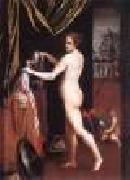 |
FONTANA, Lavinia -- Click Here
|
|
Italian Painter, 1552-1614
Daughter of Prospero Fontana. She was trained by her father and followed his Mannerist style. Her first recorded works, which date from 1575, were small paintings for private devotion, such as the Holy Family (Dresden, Gemeldegal.). By 1577 she had become established as a portrait painter in Bologna. Works of this date include the Self-portrait at the Harpsichord (Rome, Gal. Accad. S Luca) and the portrait of Senator Orsini (Bordeaux, Mus. B.-A.). Her portrait style reflects the formality of central Italian models as well as the naturalistic tendencies of the north Italian tradition. The elegantly costumed Orsini is shown seated at a table, with a suite of rooms opening behind him, a setting recalling such Florentine portraits of the 1530s as Agnolo Bronzino's Bartolommeo Panciatichi (Florence, Uffizi). Lavinia used a similar setting for other portraits, including the Gozzadini Family (1584; Bologna, Pin. N.). Female sitters are also shown in elaborate dress, with particular attention paid to details of embroidery and jewels, and they are often accompanied by small dogs |
|
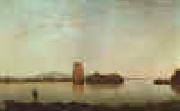 |
Fitz Hugh Lane -- Click Here
|
|
1804-1865
Fitz Henry Lane was born on December 19, 1804, in Gloucester, Massachusetts. Lane was christened Nathaniel Rogers Lane on March 17, 1805, and would remain known as such until he was 27. It was not until March 13, 1832 that the state of Massachusetts would officially grant Lane??s own formal request (made in a letter dated December 26, 1831) to change his name from Nathaniel Rogers to Fitz Henry Lane. As with practically all aspects of Lane??s life, the subject of his name is one surrounded by much confusion??it was not until 2005 that historians discovered that they had been wrongly referring to the artist as Fitz Hugh, as opposed to his chosen Fitz Henry, and the reasons behind Lane??s decision to change his name, and for choosing the name he did, are still very unclear.
From the time of his birth, Lane would be exposed to the sea and maritime life??a factor that obviously had a great impact his later choice of subject matter. Many circumstances of his young life ensured Lane??s constant interaction with various aspects of this maritime life, including the fact that Lane??s family lived ??upon the periphery of Gloucester Harbor??s working waterfront,?? , and that his father, Jonathan Dennison Lane, was a sailmaker, and quite possibly owned and ran a sail loft. It is often speculated that Lane would most likely have pursued some sea-faring career, or become a sail-maker like his father, instead of an artist, had it not been for a life-long handicap Lane developed as a child. Although the cause cannot be known with complete certainty, it is widely accepted most plausible that the ingestion of some part of the Peru-Apple??a poisonous weed also known as jimsonweed??by Lane at the age of eighteen months caused the paralysis of the legs from which Lane would never recover. It is suggested, and seems logical to assume, that because he could not play games as the other children did, he was forced to find some other means of amusement, and that in such a pursuit he discovered and was able to develop his talent for drawing. To go a step further, as a result of his having a busy sea-port as immediate surroundings, he was able to develop a special skill in depicting the goings-on inherent in such an environment.
It is true that Lane could still have become a sail-maker, as such an occupation entailed much time spent sitting and sewing, and that Lane already had some experience sewing from his short-lived apprenticeship in shoe-making. However, as evidenced in this quote from Lane??s nephew Edward Lane??s ??Early Recollections,?? his interest in art held much sway in his deciding on a career: ??Before he became an artist he worked for a short time making shoes, but after a while, seeing that he could draw pictures better than he could make shoes he went to Boston and took lessons in drawing and painting and became a marine artist.??
Lane acquired such ??lessons?? by way of his employment at Pendleton??s lithography shop in Boston, which lasted from 1832 to 1847. With the refinement and development of his artistic skills acquired during his years working as a lithographer, Lane was able to successfully produce marine paintings of high quality, as evidenced in his being listed, officially, as a ??marine painter?? in the Boston Almanac of 1840. Lane continued to refine his painting style, and consequently, the demand for his marine paintings increased as well.
Lane had visited Gloucester often while living in Boston, and in 1848, he returned permanently. In 1849, Lane began overseeing construction of a house/studio of his own design on Duncan??s Point??this house would remain his primary residence to the end of his life. Fitz Henry Lane continued to produce beautiful marine paintings and seascapes into his later years. He died in his home on Duncan??s Point on August 14, 1865, and is buried in Oak Grove Cemetery. |
|
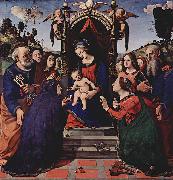 |
Fitz Henry Lane -- Click Here
|
|
(December 19, 1804 - August 14, 1865) was an American painter and printmaker of a style that would later be called Luminism, for its use of pervasive light.
Fitz Henry Lane was born on December 19, 1804, in Gloucester, Massachusetts. Lane was christened Nathaniel Rogers Lane on March 17, 1805, and would remain known as such until he was 27. It was not until March 13, 1832 that the state of Massachusetts would officially grant Lanees own formal request (made in a letter dated December 26, 1831) to change his name from Nathaniel Rogers to Fitz Henry Lane. As with practically all aspects of Lanees life, the subject of his name is one surrounded by much confusioneit was not until 2005 that historians discovered that they had been wrongly referring to the artist as Fitz Hugh, as opposed to his chosen Fitz Henry, and the reasons behind Lanees decision to change his name, and for choosing the name he did, are still very unclear.
|
|
 |
Filippino Lippi -- Click Here
|
|
Italian
1457-1504
Filippino Lippi Galleries
Born Filippo Lippi in Prato (Tuscany), the illegitimate son of the painter Fra Filippo Lippi and nun Lucrezia Buti, Filippino first trained under his father. They moved to Spoleto, where Filippino served as shop adjuvant in the construction of the Cathedral there. When his father died in 1469, he completed the frescos with Storie della Vergine (Histories of the Virgin) in the cathedral. Filippino Lippi completed his apprenticeship in the workshop of Botticelli, who had been a pupil of Filippino's father. In 1472, Botticelli also took him as his companion in the Compagnia di San Luca.
His first works greatly resemble those of Botticelli's, but with less sensitivity and subtlety. The very first ones (dating from 1475 onwards) were initially attributed to an anonymous "Amico di Sandro" ("Friend of Botticelli"). Eventually Lippi's style evolved into a more personal and effective one in the years 1480-1485. Works of the early period include: the Madonnas of Berlin, London and Washington, the Journeys of Tobia of the Galleria Sabauda in Turin, Italy, the Madonna of the Sea of Galleria dell'Accademia and the Histories of Ester.
Together with Perugino, Ghirlandaio and Botticelli, Lippi worked on the frescoed decoration of Lorenzo de Medici's villa at Spedaletto. On December 31, 1482 he was commissioned to work on a wall of Sala dell'Udienza of Palazzo Vecchio in Florence (a work never begun). Soon after (probably in 1483-1484) he was called to complete Masaccio's decoration of Brancacci Chapel in the church of the Carmine, left unfinished by the artist's death in 1428 . Here he realized the Stories of Saint Peter on the following frescoes: Quarrel with Simon Magus in face of Nero, Resurrection of Teophilus' Son, Saint Peter Jailed, Liberation and Saint Peter's Crucifixion.
The work on the Sala degli Otto di Pratica, in the Palazzo Vecchio, started on February 20, 1486. It is now in the Uffizi Gallery. In the same years Piero di Francesco del Pugliese asked him to paint the altarpiece with Apparition of the Virgin to St. Bernard, now in the Badia Fiorentina, Florence. This is Lippi's most popular picture: a composition of unreal items, with its very particular elongated figures, backed by a phantasmagorical scenario of rocks and almost anthropomorphic trunks. The work can be dated to the 1480-1486 years.
Eventually he worked for Tanai de' Nerli in the Saint Spirit's Church.
On April 21, 1487, Filippo Strozzi asked him to decorate the family chapel in Santa Maria Novella with the Stories of St. John Evangelist and St. Philip. He worked on this piece intermittently, only completing it in 1503, after the customer's death. The windows with musical themes, also designed by Filippino, were completed between June and July 1503. These paintings can be seen as a mirror of the political and religious crisis in Florence at the time: the theme of the fresco, the clash between Christianity and Paganism, was hotly debated in the Florence of Girolamo Savonarola.
Filippino showed his characters in a landscape which recreated the ancient world in its finest details, showing the influence of the Grottesco style he had seen in his journey to Rome. He created in this way an "animated", mysterious, fantastic but also disquieting style, showing the unreality of something as a nightmare. In this way, Filippino portrayed ruthless executioners deformed by grim faces, who raged against the Saints. In the scene with St. Philip expelling a monster from the temple, the statue of the pagan god is a living figure which seems to dare the Christian saint.
In 1488, Lippi moved to Rome, where Lorenzo de' Medici had advised Cardinal Oliviero Carafa to entrust him the decoration of the family chapel in Santa Maria sopra Minerva. These frescoes show a new kind of inspiration, quite different from the earlier works, but confirm his continued research on the themes of the Ancient era. Lippi finished the cycle by 1493.
Lippi's return to Florence is variously assigned to the years going from 1491 to 1494 . Works of this period include: Apparition of Christ to Madonna (1493, now in Munich), Adoration of the Magi (1496, for the church of San Donato in Scopeto, now in the Uffizi), Sacrifice of Lacoön (end of the century, for the villa of Lorenzo de' Medici at Poggio a Caiano), St. John Baptist and Maddalena (Valori Chapel in San Procolo, Florence, inspired in some way to Luca Signorelli's art). He also worked outside of his mother-country, namely on the Certosa of Pavia and in Prato, where in 1503 he completed the Tabernacle of the Christmas Song, now in the City Museum; in 1501 Lippi realized the Mystic Wedding of St. Catherine for the Basilica of San Domenico in Bologna.
Lippi's last work is the Deposition for the Santissima Annunziata church in Florence, which at his death in April 1504 was unfinished.
He was so renowned that all the workshops of the city closed on the day of his burial. |
|
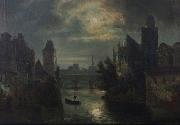 |
Ferdinand Lepie -- Click Here
|
|
painted River by night in 1872 |
|
|
|
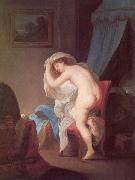 |
Felix Ivo Leicher -- Click Here
|
|
painted The Evening in 1780s
|
|
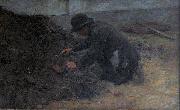 |
Evert Larock -- Click Here
|
|
painted Cinder clearance in |
|
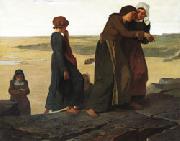 |
Evariste Vital Luminais -- Click Here
|
|
(October 13, 1822 - 1896) was a French painter.
He was born in Nantes. He scored a success at the Paris Salon of 1884 with the painting Flight of King Gradlon. Another Luminais' important painting is The Sons of Clovis II.
|
|
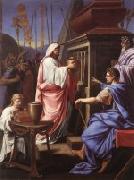 |
Eustache Le Sueur -- Click Here
|
|
French Baroque Era Painter, 1616-1655.
French painter and draughtsman. He was one of the most important painters of historical, mythological and religious pictures in 17th-century France and one of the founders of French classicism. He was long considered the 'French Raphael' and the equal of Nicolas Poussin and Charles Le Brun. His reputation reached its zenith in the first half of the 19th century, but since then it has been in decline, largely as a result of the simplified and saccharine image of the man and his art created by Romantic writers and painters. Nevertheless, more recent recognition of the complexity of his art has resulted in a new interest in him and in his place in the evolution of French painting in the 17th century. Despite the almost total absence of signed and dated works, the chronology of Le Sueur's oeuvre can be established with the aid of a few surviving contracts, dated engravings after his paintings and the list of works published by Le Comte in 1700. |
|
|
|
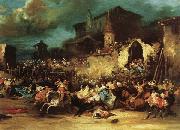 |
Eugenio Lucas Velazquez -- Click Here
|
|
Madrid artist , 1817-1870
|
|
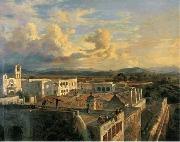 |
Eugenio Landesio -- Click Here
|
|
painted La hacienda de Colon in 1857 - 1858
|
|
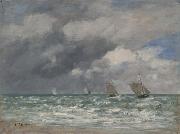 |
Eugene Louis Boudin -- Click Here
|
|
(12 July 1824 - 8 August 1898) was one of the first French landscape painters to paint outdoors.
Boudin was a marine painter, and expert in the rendering of all that goes upon the sea and along its shores. His pastels, summary and economic, garnered the splendid eulogy of Baudelaire, and Corot who, gazing at his pictures, said to him, "You are the master of the sky."
Born at Honfleur, France, he worked in a small art shop where Claude Monet displayed his art work Le Havre and Honfleur across the estuary of the Seine. But before old age came on him, Boudin's father abandoned seafaring, and his son gave it up too, having no real vocation for it, though he preserved to his last days much of a sailor's character, frankness, accessibility, and open-heartedness.
In 1835, his family moved to Le Havre, where his father established himself as stationer and frame-maker. He began work the next year as an assistant in a stationery and framing store before opening his own small shop. There he came into contact with artists working in the area and exhibited in his shop the paintings of Constant Troyon and Jean-François Millet, who, along with Jean-Baptiste Isabey and Thomas Couture whom he met during this time, encouraged young Boudin to follow an artistic career. At the age of 22 he abandoned the world of commerce, started painting full-time, and traveled to Paris the following year and then through Flanders. In 1850 he earned a scholarship that enabled him to move to Paris, although he often returned to paint in Normandy and, from 1855, made regular trips to Brittany.
The Beach at Villerville, 1864. Eugene Boudin. Oil on canvas. National Gallery of Art, Washington DC. (Zoomview)
Rivage de Pontrieux, Cotes-du-Nord. 1874. Eugene Boudin.
Landscape with Sunset. 1880-1890. Watercolour. Musee d'Orsay, Paris
Berck, Fishermen at Low TideDutch 17th century masters profoundly influenced him, and on meeting the Dutch painter Johan Jongkind, who already made his mark in French artistic circles, Boudin was advised by his new friend to paint outdoors (en plein air). He also worked with Troyon and Isabey, and in 1859 met Gustave Courbet who introduced him to Charles Baudelaire, the first critic to draw Boudines talents to public attention when the artist made his debut at the 1859 Paris Salon.
In 1856/57 Boudin met the young Claude Monet who spent several months working with Boudin in his studio. The two remained lifelong friends and Monet later paid tribute to Boudines early influence. Boudin joined Monet and his young friends in the first Impressionist exhibition in 1874, but never considered himself a radical or innovator.
Boudines growing reputation enabled him to travel extensively in the 1870s. He visited Belgium, the Netherlands, and southern France, and from 1892 to 1895 made regular trips to Venice. He continued to exhibit at the Paris Salons, receiving a third place medal at the Paris Salon of 1881, and a gold medal at the 1889 Exposition Universelle. In 1892 Boudin was made a knight of the Legion d'honneur, a somewhat tardy recognition of his talents and influence on the art of his contemporaries.
Late in his life he returned to the south of France as a refuge from ill-health, and recognizing soon that the relief it could give him was almost spent, he returned to his home at Deauville, to die within sight of Channel waters and under Channel skies.
|
|
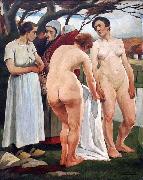 |
Eugene Laermans -- Click Here
|
|
painted Women Bathing in 1907
1864-1940 |
|
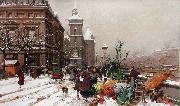 |
Eugene Galien-Laloue -- Click Here
|
|
French 1854-1941
was a French artist of French-Italian parents and was born in Paris on December 11, 1854. He is recognized as a master of French impressionist street scenes spanning four decades. His work is sought out by collectors all over the world. Well-known in France, his paintings of the early 1900s accurately represent the era in which he lived: a happy, bustling Paris, la Belle Époque, with horse-drawn carriages, trolley cars and its first omnibuses. Galien-Laloue's works are valued not only for their contribution to 20th century art, but for the actual history, which they document. He was a populariser of street scenes, usually painted in autumn or winter. His work can be seen at the Musee des Beaux-Arts, Louvier; Musee des Beaux-Arts, La Rochelle; Mulhouse, France. Galien-Laloue has inspired and influenced many of yesterday's and today's artists, including renowned French impressionists Edouard Leon Cortes and Antoine Blanchard. A typical Galien-Laloue painting depicts sidewalks and avenues crowded with people or tourists mingling before the capital's monuments. He also painted the landscapes of Normandy and Seine-et-Marne, as well as military scenes he was commissioned to produce in 1914. The Republic of France selected Galien-Laloue to work as a 'war artist,' both during the Franco-Prussian War and World War I, chiefly in watercolor. "He was originally trained as an architect, but did not enjoy the promotional aspects of the profession. Under the tutelage of Charles Laloue, he quickly gained fame as an artist, specializing in watercolor and gouache." "Galien-Laloue mastered the depiction of the Belle Epoque Paris street scene, much in the vein of Jean Beraud (1849-1936) or James Jacques Tissot (1836-1902). He portrayed Paris at its best: irresistible shops, boulevards and "quartiers". With delicate line and dramatic lighting, Galien-Laloue documented the daily bustle of one of the world's most beautiful cities, Paris." |
|
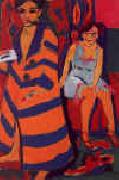 |
Ernst Ludwig Kirchner -- Click Here
|
|
German Expressionist Painter and Sculptor, 1880-1938 was a German expressionist painter and printmaker and one of the founders of the artists group Die Brucke or "The Bridge", a key group leading to the foundation of Expressionism in 20th century art. He volunteered for army service in the First World War, but soon suffered a breakdown and was discharged. In 1933, his work was branded as "degenerate" by the Nazis and in 1937 over 600 of his works were sold or destroyed. In 1938 he committed suicide. In 1913, the first public showing of Kirchner's work took place at the Armory Show, which was also the first major display of modern art in America. In 1921, U.S. museums began to acquire his work and did so increasingly thereafter. His first solo show was at the Detroit Institute of Arts in 1937. In 1992, the National Gallery of Art, Washington, held a monographic show, using its existing collection; a major international loan exhibition took place in 2003. In November 2006 at Christie's, Kirchner's Street Scene, Berlin (1913) fetched $38 million, a record for the artist. |
|
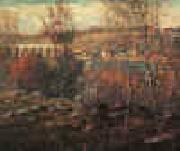 |
Ernest Lawson -- Click Here
|
|
1873-1939
Ernest Lawson Galleries
Ernest Lawson (March 22, 1873 ?C December 18, 1939) was a Canadian-American painter and a member of The Eight, a group of artists which included the group's leader Robert Henri, Everett Shinn, John Sloan, Arthur B. Davies, Maurice Prendergast, George Luks, and William J. Glackens.
Lawson was born in Halifax, Nova Scotia. Though Lawson mostly painted landscapes, he also did some realistic urban scenes which were shown at the 1908 exihibition of The Eight. His painting style is heavily influenced by Impressionism, especially the style of John Henry Twachtman, Alfred Sisley, and J. Alden Weir.
Lawson exhibited as a member of the Canadian Art Club from 1911 to 1915. He died in Miami Beach, Florida in 1939. |
|
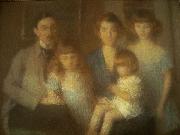 |
Ernest Laurent -- Click Here
|
|
(June 8, 1859 -- June 25, 1929) was a French painter and printmaker. He was born in Gentilly and died in Bievre.
Laurent was a neo-impressionist artist whose main influences were his instructor Ernest Hebert and his friend Georges Seurat. Laurent took second prize in the Prix de Rome in 1889 and in 1890, Laurent arrived in Rome, where Hebert remained Director of the Academie de France. From Rome, he went to Assisi where he underwent a mystical experience. It would profoundly influence his art. The work he returned to Paris from Assisi was noted for its religious themes.
Over time, profound religious devotion influenced his artistic motif and religious symbolism and scenery crept into his work. This aspect of his life ran counter to Seurat's materialism and the two parted ways.
|
|
|
|
|
| | |
|
|
|
|